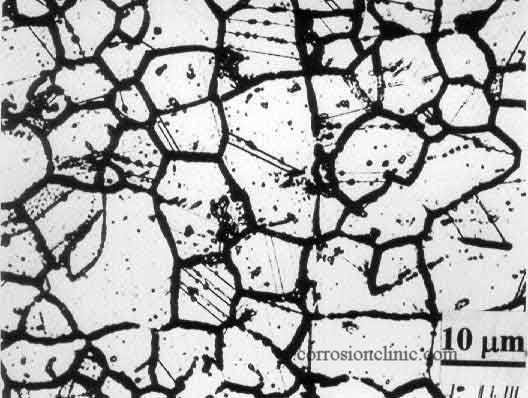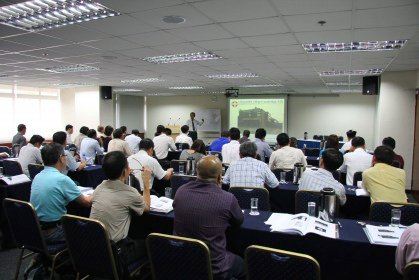|
 |
|
Home |
Consulting |
Training |
Expert Witness |
Failure Analysis |
Design Review |
Corrosion Test |
Corrosion Software |
Protective Coatings |
Materials Selection |
Cathodic Protection |
>>> |
|
Corrosion, Metallurgy, Failure Analysis and Prevention |
|
Course Outline |Who Should Attend |Registration |In-House |On-Demand |Online Courses |PPT Slides+Testbank |Course List
|
Why WebCorr
|
|
Course Overview |
|
 This
5-day corrosion short course aims to
provide the participants with an understanding of why and how corrosion
occurs, the metallurgical and environmental factors influencing
corrosion, and practical methods of corrosion control and failure
prevention. Participants will be able to grasp the basic concepts
related to corrosion, metallurgy and failure analysis, and to apply the
state of the art technology in their workplace. This
5-day corrosion short course aims to
provide the participants with an understanding of why and how corrosion
occurs, the metallurgical and environmental factors influencing
corrosion, and practical methods of corrosion control and failure
prevention. Participants will be able to grasp the basic concepts
related to corrosion, metallurgy and failure analysis, and to apply the
state of the art technology in their workplace.
This corrosion short course is
available for in-house training, online and distance learning worldwide.
It can also be customized to meet the specific needs of your
organization.
|
|
|
|
Course Outline |
|
|
|
1. Basic Concepts in Corrosion
1.1 Introduction
1.2 Corrosion & Society
1.2.1 Corrosion: what it is
1.2.2 Corrosion: its economic, social, political and environmental impacts
1.3 How to avoid liabilities due to corrosion
1.4 Lessons of history
1.5 Basic concepts relevant to corrosion
1.5.1 Terminology and convention
1.5.2 Primer in chemistry and electrochemistry
1.5.3 Potential-pH diagram
1.5.4 Kinetics of corrosion
1.5.5 High temperature oxidation
2. Metallurgy and Corrosion
2.1 Introduction to Metallurgy
2.1.1 Extractive metallurgy
2.1.2 Mechanical metallurgy
2.1.3 Physical metallurgy
2.2 Metals in the melting pot
2.3 Defects in metals
2.3.1 Point defects
2.3.2 Line defects
2.3.3 Volume defects
2.4 The iron-carbon phase diagram
2.5 The microstructure of common metals/alloys
2.6 Different Forms of Corrosion: Mechanisms, Recognition & Prevention
2.6.1 Uniform corrosion
2.6.2 Galvanic corrosion
2.6.3 Dealloying and Graphitisation
2.6.4 Crevice corrosion
2.6.5 Pitting corrosion
2.6.6 Intergranular corrosion and weld decay
2.6.7 Exfoliation
2.6.8 Filiform corrosion
2.6.9 Microbiologically-influenced corrosion (MIC)
2.6.10 Environment-sensitive cracking
2.6.11 Hydrogen damages
2.6.12 Corrosion fatigue
2.6.13 Fretting
2.6.14 Erosion corrosion, impingement attack and cavitation damage
2.6.15 Stray current corrosion
3. Weldment Metallurgy and Corrosion
3.1 Weldment metallurgy and weldment corrosion
3.1.1 Factors affecting weldment corrosion
3.1.2 Methods of welding
3.1.3 Welding austenitic SS vs carbon steel
3.1.4 Residual stress and stress concentration
3.1.5 Weld defects
3.1.6 Weld metallurgy
3.1.7 Weld metal composition
3.1.8 Iron contamination: its effects & removal
3.1.9 Heat tint: its effects & removal
3.1.10 Summary of fabrication defects
3.2 Precipitation of intermetallics (sigma, chi & Laves phases)
in stainless steels
3.2.1 Microstructural features in SS
3.2.2 Precipitation of delta ferrite and Schaeffler Diagram
3.2.3 Alpha prime phase and 475°C embrittlement
3.2.4 Precipitation of intermetallics:
submicroscopic sigma, chi and Laves phases
3.2.5 Chemical compositions of various intermetallics and phases
3.2.6 Time-Temperature-Precipitation diagrams for
sigma, chi and Laves phases and carbides
3.2.7 Effect of chemical composition on sigma precipitation
3.2.8 Effect of Nitrogen on sigma precipitation
3.2.9 Effect of cold working on sigma precipitation
3.2.10 Invisible (submicroscopic) sigma/chi phases and their effects on corrosion
3.2.11 Time-temperature-precipitation curves for various austenitic stainless
steels: precipitation of carbides, sigma, chi and Laves phases
3.3 Intergranular corrosion, weld decay and knifeline attack
3.3.1 Sensitization of austenitic stainless steels
3.3.2 Cr profile along the grain boundaries
3.3.3 Effect of carbon, molybdenum and nitrogen on
time-temperature- precipitation diagrams
3.3.4 Effect of cold working and applied stress
3.3.5 Sensitization of Ferritic Stainless Steels
3.3.6 Sensitization of Duplex Stainless Steels
3.3.7 Effect sulfide inclusions in stainless steels
3.3.8 Ferritic and duplex stainless steels
3.3.9 Nickel-chromium alloys
3.3.10 Aluminum alloys
3.3.11 Weld decay and knifeline attack on austenitic stainless steels
3.4 Why is weldment
particularly susceptible to microbiologically influenced corrosion?
3.5 Weldment corrosion of various alloy systems
3.5.1 Austenitic stainless steels
3.5.2 Ferritic stainless steels
3.5.3 Nickel alloys
3.5.4 Duplex stainless steels
3.5.5 Carbon steels
3.5.6. Aluminum
3.6 Corrosion under insulation
3.7 Corrosion in atmosphere
4. Failure Analysis and Prevention
4.1 General approach to failure analysis
4.2 General methods of failure prevention
4.3 Corrosion Resistant Coatings
4.4 Cathodic & Anodic Protection
4.5 Corrosion Inhibitors
4.6 Corrosion Testing & Monitoring
4.7
Software Solutions to Industrial Corrosion: Overview of
Corrosion Modeling and Corrosion Prediction Software
-
ABC-Compass: Ammonium Bisulfide Corrosion Modeling and Life Prediction
-
ACE - Apps for Corrosion Engineers: A Collection of Essential
Corrosion Software Applications for Corrosion Engineers,
Corrosion Researchers, and Corrosion Technicians in
Laboratories and in Fields
-
ACMF-Compass: Modeling and Prediction of the Effects
of AC and Magnetic Field on Metal Corrosion
-
Atmosphere-Compass: Prediction and Modeling of Atmospheric
Corrosion of Metals and Alloys
-
CCC-Compass: Modeling and Prediction of Caustic Corrosion and Caustic
Stress Corrosion Cracking
-
CIPAL-Compass: Copper-Induced Pitting in Aluminium Alloys - Modeling, Life Prediction and Process Control
-
CO2Compass: Modeling and Prediction of Corrosion by Carbon
Dioxide (CO2), Hydrogen Sulfide (H2S), Acetic Acid (HAc), Elemental
Sulfur (S), and Mercury (Hg) in Oil and Gas Pipelines and Production
Tubing
-
Concrete-Compass: Concrete Corrosion Prediction and
Modeling
-
CP-Compass-Pipeline: Cathodic Protection Design Calculations, Verification, Assessment and Solution for Underground Pipelines
-
CP-Compass-Concrete: Design Calculations for Cathodic Protection of Reinforced Concrete Structures
-
CRA-Compass: Corrosion Modeling and Corrosion Prediction for
Corrosion Resistant Alloys - the Threshold Temperature and Chloride
Concentration for Pitting, Crevice Corrosion, and Stress Corrosion
Cracking (SCC)
-
CSR-Compass: Modeling and Remaining Life Prediction of Creep
and Stress Rupture of Boiler and Heater Tubes
-
CUI-Compass: Prediction and Risk Assessment of Corrosion Under Insulation and Fireproofing
-
Dew-Point-Compass: Prediction of Dew Point Temperatures of Flue Gases and the Risk of Dew Point Corrosion
-
DWD-Compass: Modeling and Life Prediction of Corrosion in Drinking Water Distribution Systems
-
EVS-Compass: Extreme Value Statistics in Corrosion Modeling and Corrosion Life Prediction of Structures and Plant Assets
-
FAC-Compass:
Erosion Corrosion and Flow - Accelerated Corrosion Modeling, Life Prediction and Materials
Selection in Water-Steam Systems
-
FuelAsh-Compass: Fuel Ash Corrosion Modeling and Life Prediction of
Boiler and Heater Tubes
-
GC-Compass: Galvanic Corrosion Prediction and Materials Compatibility Assessment
-
H2Compass: Modeling and Prediction of Low Temperature Hydrogen Damages
(Hydrogen Blistering, Hydrogen-Induced Cracking, Hydrogen Embrittlement) and High Temperature Hydrogen Attack (HTHA)
-
H2SO4-Compass: Corrosion Prediction and Materials Selection
Guide for H2SO4 Services
-
HCl-Compass: Corrosion Prediction and Materials
Selection Guide for HCl Services
-
ISO15156-Compass: Modeling and Prediction of in-situ
pH, Region of Environmental Severity, and Susceptibility to
Sulfide Stress Cracking (SSC) of Carbon and Low Alloy Steels
-
NAC-Compass: Modeling and Prediction of High Temperature Naphthenic Acid Corrosion
-
O2Compass: Modeling and Prediction of High Temperature Oxidation
-
OCTG-Compass: Corrosion Prediction and CRA Materials
Selection Guide for Oil and Gas Production Systems
-
PipelineCompass: Pipeline Corrosion Modeling, Prediction, Assessment and Solutions
-
PCW-Compass: Corrosion Prediction and Modeling in
Process Cooling Water Systems
-
SC-Compass: Stray Current
Corrosion and AC Corrosion - Identification, Assessment and
Prediction
-
S-Compass:
Modeling and Prediction of High Temperature Sulfidation/Sulfidic
Corrosion/H2-H2S Corrosion and Low Temperature Elemental Sulfur
Corrosion
-
Seawater-Compass: Seawater Corrosion Prediction for
Metals and Alloys
-
Shipwreck-Compass: Shipwreck Corrosion Modeling and Corrosion
Prediction
-
Soil-Compass: Soil Corrosion Prediction and Modeling for
Metals and Alloys
-
VPC-Compass: Prediction and Modeling of Internal Corrosion in Vapor Phase in Closed Systems
-
VPC-Compass-SE: Prediction and Modeling of Corrosion in Microelectronic Packages
|
|
Course Outline |Who Should Attend |Registration |In-House |On-Demand |Online Courses |PPT Slides+Testbank |Course List
|
|
Who Should Attend
This Corrosion Course |
|
This 5-day course provides an excellent avenue for
corrosion practitioners, failure analysis personnel, designers, technical
managers, inspection and maintenance engineers, coatings and weld inspectors,
quality control personnel and anyone who is interested in corrosion, metallurgy
and materials failure analysis and its prevention.
Successful completion of this corrosion course helps participants
prepare for their NACE certification examinations at the Corrosion Technician,
Corrosion Technologist and Senior Corrosion Technologist levels.
|
|
Registration
for This Corrosion Course |
|
Click
here to register for this corrosion course online,
or
Click
here to download this corrosion course brochure with
registration form in PDF format.
|
|
In-House Training Corrosion Courses |
|
 If you are concerned with corrosion in your
company, in-house training or on-site training is a great solution to train a group of
employees from design, production, operation, quality assurance, inspection
and maintenance, and technical sales and support on corrosion control and
corrosion prevention technology. The contents of all our corrosion courses can
be customized to fit your organization's needs. If you are concerned with corrosion in your
company, in-house training or on-site training is a great solution to train a group of
employees from design, production, operation, quality assurance, inspection
and maintenance, and technical sales and support on corrosion control and
corrosion prevention technology. The contents of all our corrosion courses can
be customized to fit your organization's needs.
There is no limit to the number of participants required for
in-house training corrosion courses. We conduct the in-house training
corrosion course at your company's premises worldwide, and at a time convenient to
your company.
Click
here to contact us
for a quotation for in-house training corrosion courses. |
|
Corrosion
Course-On-Demand |
|
 All our publicly scheduled corrosion short courses are conducted once a year. However, you do not need to wait for one year if you have missed any of the publicly scheduled corrosion courses as we have this unique corrosion course-on-demand scheme: we will conduct the course just for you
(on an one-on-one basis) or for a small group from your company at a time and in a location convenient to you. This option costs significantly less than a full-scale in-house
or on-site corrosion training program. All our publicly scheduled corrosion short courses are conducted once a year. However, you do not need to wait for one year if you have missed any of the publicly scheduled corrosion courses as we have this unique corrosion course-on-demand scheme: we will conduct the course just for you
(on an one-on-one basis) or for a small group from your company at a time and in a location convenient to you. This option costs significantly less than a full-scale in-house
or on-site corrosion training program.
Click
here to contact us for a quotation. |
|
Online and Distance Learning Corrosion
Courses |
|
 All
our corrosion short courses are available for online or offline distance
learning. You can start an online corrosion course at any time and learn
at your own comfortable pace and schedule, whenever and wherever you
are. You have around-the-clock access to the interactive and media-rich
course materials, virtual labs, course instructions and course assessments. Discussions and questions related to the corrosion courses
are posted on the website or exchanged through email for a period up to 3 months. Video conferencing or instant messaging can also be arranged for discussions of course topics.
For those who do not have ready access to internet, we can send
you our online course materials on a CD-ROM, or DVD, or USB flash drive for offline
distance learning. All
our corrosion short courses are available for online or offline distance
learning. You can start an online corrosion course at any time and learn
at your own comfortable pace and schedule, whenever and wherever you
are. You have around-the-clock access to the interactive and media-rich
course materials, virtual labs, course instructions and course assessments. Discussions and questions related to the corrosion courses
are posted on the website or exchanged through email for a period up to 3 months. Video conferencing or instant messaging can also be arranged for discussions of course topics.
For those who do not have ready access to internet, we can send
you our online course materials on a CD-ROM, or DVD, or USB flash drive for offline
distance learning.
Click
here to to register an online corrosion short course. |
|
|
|
PowerPoint Slides and Test Banks for Trainers,
Instructors, Tutors, University Lecturers and Professors |
|
If you are involved in teaching or
training, you may wish to purchase a complete set of the trainer's
package for this training course. The trainer's
package comes complete with ready-to-use PowerPoint slides (fully
editable) and test bank (with answer keys). These ready-to-use
PowerPoint slides contain high quality color photographs, illustrations,
animations, audio and video clips. The test bank contains questions
in four categories: (1) true or false, (2)
multiple choice, (3) calculation, and (4) reasoning and open-ended
discussions. The trainer's package is suitable for in-house training and
university teaching. This is exactly the same package that WebCorr uses to deliver our
current training course.
The one-time lump sum fee allows your
organization to use the training package and also modify it. For
example, your organization may modify the course contents and
re-name/re-brand the course under your organization’s name. WebCorr only
retains the copyright of the original PowerPoint slides and test bank.
Click
here to contact us if you need more information on the trainer's package.
|
|
Course Outline |Who Should Attend |Registration |In-House |On-Demand |Online Courses |PPT Slides+Testbank |Course List
|
|
Home |
Contact Us |
Copyright
©
1995-2025.. All rights reserved. |
 This
5-day corrosion short course aims to
provide the participants with an understanding of why and how corrosion
occurs, the metallurgical and environmental factors influencing
corrosion, and practical methods of corrosion control and failure
prevention. Participants will be able to grasp the basic concepts
related to corrosion, metallurgy and failure analysis, and to apply the
state of the art technology in their workplace.
This
5-day corrosion short course aims to
provide the participants with an understanding of why and how corrosion
occurs, the metallurgical and environmental factors influencing
corrosion, and practical methods of corrosion control and failure
prevention. Participants will be able to grasp the basic concepts
related to corrosion, metallurgy and failure analysis, and to apply the
state of the art technology in their workplace.  If you are concerned with corrosion in your
company, in-house training or on-site training is a great solution to train a group of
employees from design, production, operation, quality assurance, inspection
and maintenance, and technical sales and support on corrosion control and
corrosion prevention technology. The contents of all our corrosion courses can
be customized to fit your organization's needs.
If you are concerned with corrosion in your
company, in-house training or on-site training is a great solution to train a group of
employees from design, production, operation, quality assurance, inspection
and maintenance, and technical sales and support on corrosion control and
corrosion prevention technology. The contents of all our corrosion courses can
be customized to fit your organization's needs.
 All our publicly scheduled corrosion short courses are conducted once a year. However, you do not need to wait for one year if you have missed any of the publicly scheduled corrosion courses as we have this unique corrosion course-on-demand scheme: we will conduct the course just for you
(on an one-on-one basis) or for a small group from your company at a time and in a location convenient to you. This option costs significantly less than a full-scale in-house
or on-site corrosion training program.
All our publicly scheduled corrosion short courses are conducted once a year. However, you do not need to wait for one year if you have missed any of the publicly scheduled corrosion courses as we have this unique corrosion course-on-demand scheme: we will conduct the course just for you
(on an one-on-one basis) or for a small group from your company at a time and in a location convenient to you. This option costs significantly less than a full-scale in-house
or on-site corrosion training program. All
our corrosion short courses are available for online or offline distance
learning. You can start an online corrosion course at any time and learn
at your own comfortable pace and schedule, whenever and wherever you
are. You have around-the-clock access to the interactive and media-rich
course materials, virtual labs, course instructions and course assessments. Discussions and questions related to the corrosion courses
are posted on the website or exchanged through email for a period up to 3 months. Video conferencing or instant messaging can also be arranged for discussions of course topics.
For those who do not have ready access to internet, we can send
you our online course materials on a CD-ROM, or DVD, or USB flash drive for offline
distance learning.
All
our corrosion short courses are available for online or offline distance
learning. You can start an online corrosion course at any time and learn
at your own comfortable pace and schedule, whenever and wherever you
are. You have around-the-clock access to the interactive and media-rich
course materials, virtual labs, course instructions and course assessments. Discussions and questions related to the corrosion courses
are posted on the website or exchanged through email for a period up to 3 months. Video conferencing or instant messaging can also be arranged for discussions of course topics.
For those who do not have ready access to internet, we can send
you our online course materials on a CD-ROM, or DVD, or USB flash drive for offline
distance learning.